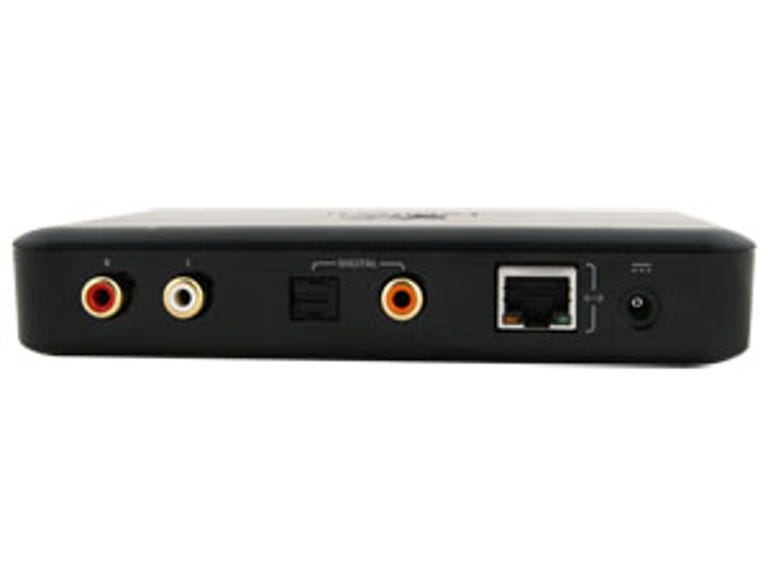 Why You Can Trust CNET
Why You Can Trust CNET Logitech Squeezebox Duet review: Logitech Squeezebox Duet
If you can work an iPod, you can work the Logitech Squeezebox Duet. This multi-room audio streamer is easy to use and attractive, too. It supports a plethora of codecs and could be the best, most enjoyable way of setting your PC's music collection free
We're all getting more comfortable with media servers, digital music libraries and streaming home audio. Logitech has brought the new Squeezebox Duet to market to help make streaming simple -- at least that's what we're told.
The Good
The Bad
The Bottom Line
The complete package will cost you around £240 and is available now. Should Sonos be seeking shelter? We sense a storm brewing.
Design
Logitech's beautifully packaged Squeezebox system comprises three things: a small black box -- the Squeezebox -- that connects to your hi-fi, a wireless remote control and a small piece of software that sits on your computer. The stylish Squeezebox itself is a little smaller than a VHS tape -- remember those? -- and features a single button on the front that you use in the event you want to reboot the system. It has RCA connections to the rear, digital-out, an Ethernet socket and a power input. Simple.

The internal battery-controlled remote is what you'll be using to navigate your music collection and it's got a big 61mm (2.4-inch) colour screen to help, with terrific clarity and intuitive navigation -- it's a real joy to use. Included is a weighted mains-powered base station for charging the remote, and the battery is user-replaceable.
Features
Thankfully, the open-source, MySQL-based software runs on PC, Mac and Linux, and is as simple to use as hardware. There's lots of customisation available for expert users, but novices won't be faced with these options unless they seek them out, so technophobes and IT professionals will enjoy the software equally. It's attractive, too, with a clean black interface. You're also able to remotely control the Squeezebox from this Web browser-based software -- known lovingly as the SqueezeCenter; pausing a song on your computer, for example, pauses it on your hi-fi.
Squeezebox supports a plethora of audio formats natively, including MP3, WMA, FLAC, WAV, AIFF and OGG. But that's not all -- choose to play any AAC, Apple Lossless, WMA Lossless, Monkeys Audio (.APE), MusePack or WavPack files and the SqueezeCenter software transcodes it on the fly into lossless FLAC or WAV without fuss. Using the remote control, you'll never even see or notice this happening; the system simply plays the file after a couple of seconds of transcoding as if the hardware supported it natively.
You needn't tell the software to simply monitor a folder in Windows that you want to be able to browse through Squeezebox, as it'll connect to your iTunes library -- including playlists -- and offer you any files located inside it.
But that's still not all. Squeezebox will report the songs you play to your Last.fm account, give you access to Internet radio from such services as Live365 and ShoutCast, and it'll play podcasts that you've subscribed to using the SqueezeCenter. You've also got instant access to the hundreds of public albums available from the Internet Archive, among others. This gargantuan platter of free, on-demand music is just phenomenal for music lovers, young and old.
Performance
This streaming all requires a network connection, of course, and both Ethernet, unsecured Wi-Fi and secured Wi-Fi methods are supported. We had initial problems due to our complicated corporate Wi-Fi, but once we hooked up via Ethernet we were listening to music within a couple of minutes. The software is a breeze to use, as is the Squeezebox's remote control.
We didn't even notice any network lag. The remote was, on occasion, unresponsive, but it didn't interrupt our listening. Our Denon CX3 reference hi-fi was blasting our Apple Lossless library instantly -- we didn't even notice a lag as the PC transcoded the audio file either. Sound quality was terrific, with no stutters or skips. Could anything make us even happier with this system?
Yes, apparently. Our rip of Muse's Hullabaloo live album played without gaps -- that's right, gapless playback is supported. Even album art popped up on the remote control's delightful screen as we listened. Should you want a Squeezebox in multiple rooms, the remote lets you choose whichever one you want to listen to at any given time.
Our complaints are only minor. You have to download the SqueezeCenter software, as it's not in the box. We would also have liked to see a USB port on the Squeezebox so friends could add their music to that available on the network, browsable with the remote control. A brighter LCD screen wouldn't have gone amiss either, as it's not terrific in bright sunlight or outdoors.
Conclusion
Our favourite audio gadget of 2008 so far is the Squeezebox Duet. It's just an amazing, easy to use and intuitive product -- if you can work an iPod, you'll be able to use the Duet. We have only minor complaints, as on the whole, this is probably the best, most enjoyable way of setting your PC's music collection free. It may cost you a few quid, but it's worth every penny.
If you want integration with Napster's paid-for on-demand library, check out the Sonos music system. It too is a fantastic setup and comes with a built-in amplifier, negating the need for a separate hi-fi or amp.
Edited by Shannon Doubleday
